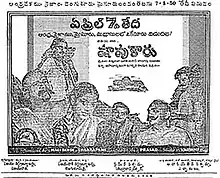| Shavukaru | |
|---|---|
 Theatrical release poster | |
| Directed by | L. V. Prasad |
| Written by | Chakrapani (story/dialogues) |
| Screenplay by | L. V. Prasad |
| Produced by | Chakrapani Nagi Reddy |
| Starring | N. T. Rama Rao Sowcar Janaki |
| Cinematography | Marcus Bartley |
| Edited by | C. P. Jambulingam M. S. Mani |
| Music by | Ghantasala |
Production company | |
Release date | 7 April 1950 |
Running time | 177 minutes |
| Country | India |
| Language | Telugu |
Shavukaru (transl. Businessman) is a 1950 Indian Telugu-language drama film directed by L. V. Prasad. The film was produced by Nagireddy and Chakrapani under the Vijaya Productions banner as their maiden production. It stars N. T. Rama Rao in his first leading role after having a brief appearance as a police officer in the film Mana Desam (1949), along with debutant Janaki too in her first leading role. The music composed by Ghantasala.
The film won critical acclaim but underperformed commercially.[1][2] Shavukaru bought wide fame to the lead actress Janaki and people began referring to her as Sowcar Janaki after the film's release.[3][4] The film was remade in Tamil as Enga Veetu Penn (1965).[5]
Plot
Changayya (Subba Rao) is a wealthy Shavukaru (businessman) whose son Satyam (N. T. Rama Rao) is studying in the city. His neighbour is Ramayya (Srivatsa). Changayya is affectionate towards Ramayya's daughter Subbulu (Janaki) and wants to make her his daughter-in-law. Satyam also likes this idea.
But due to some conflict in the village courtesy of Bangarayya, Ramayya becomes the main witness against Changayya citing Changayya's hand in some messy affair. The two families are thereafter estranged. They start with petty fights, getting worse every day resulting in Satyam and Ramayya's son Narayana (Sivaram) both ending up in jail after being framed.
The local goonda Sunnapu Rangadu (S. V. Ranga Rao) plans to rob Changayya's place, but his plans are spoiled by Subbulu and Ramayya. Both the families end their differences thereafter and become friends once again. In the end, Satyam and Subbulu marry and live happily.
Cast
- N. T. Rama Rao as Satyam
- Sowcar Janaki as Subbulu
- Govindarajula Subba Rao as Shavukaru Changayya
- S. V. Ranga Rao as Sunnapu Ranga
- Relangi as Varalu
- Padmanabham as Poolayya
- Vallabhajosyula Sivaram as Narayana
- Vangara as Pantulu
- Sreevatsa as Ramayya
- Santha Kumari as Santhamma
- Kanakam as Raami
- Seeta as Manikkam
Soundtrack
Music was composed by Ghantasala. Lyrics were written by Samudrala Sr. Singers are Santha Kumari and T. Kanakam. Playback singers are Ghantasala, M. S. Rama Rao, Madhavapeddi Satyam, Pithapuram Nageswara Rao, R. Balasaraswathi Devi and Jikki.
| No. | Song | Singers | Lyrics | Length (m:ss) |
|---|---|---|---|---|
| 1 | Intēnannā nijamintēnannā guṭṭurerigina gururāyalu | Madhavapeddi Satyam | Samudrala Sr. | |
| 2 | ēmanenē cinnāri ēmanenē vannela sigapuvvā kanusannalalō | Ghantasala | ||
| 3 | telupavēlanē cilukā palukavēlanē badulu | R. Balasaraswathi Devi & Ghantasala | ||
| 4 | telupavēlanē cilukā palukavēlanē badulu palukavēlanē | R. Balasaraswathi Devi | ||
| 5 | dīpāvaḷi dīpāvaḷi iṇṭiṇṭa ānanda dīpāvaḷi māyiṇṭa | R. Balasaraswathi Devi | ||
| 6 | dīpāvaḷi dīpāvaḷi iṇṭiṇṭa ānanda | R. Balasaraswathi Devi & Santha Kumari | ||
| 7 | palukarādaṭē cilukā samukhamulō rāyabhāramendulakē | Ghantasala | ||
| 8 | Bhāgavata paṭhanaṁ | M. S. Rama Rao | ||
| 9 | balē doralaku dorakani sogasu anuvuga dorukunu raṅgayya | T. Kanakam | ||
| 10 | māripōvurā kālamu māruṭa dāniki sahajamurā | Madhavapeddi Satyam | ||
| 11 | valapula valarājā tāmasamika cālurā viriśaramulakika | Pithapuram Nageswara Rao & Jikki | ||
| 12 | virahavyadha maracukatha telupavē ō jābili | Pithapuram Nageswara Rao & Jikki | ||
| 13 | śrīlucelaṅgē bhāratabhūmina (harikatha) | Ghantasala |
References
- ↑ Narasimham, M. L. (13 April 2013). "Pathalabhairavi (1951)". The Hindu. ISSN 0971-751X. Retrieved 30 September 2022.
When Vijaya's maiden production, Shavukaru won critical acclaim but did not earn the expected profits ....
- ↑ Krishna Chaitanya (29 June 2012). "Chakrapani - A Legend Whom Legends Respect". Bharat Janani. Archived from the original on 5 May 2014. Retrieved 8 October 2022.
The film was liked by the critics but was rejected by the audience who felt that too much of realism was not their cup of tea.
- ↑ Majordasan. "Potpourri of titbits about Tamil cinema, Sowcar Janaki". Kalyanamalai. Retrieved 8 October 2017.
- ↑ Raman, Mohan V. (8 November 2014). "What's in a name?". The Hindu. Retrieved 8 October 2017.
- ↑ Narasimham, M. L. (13 August 2015). "Milestone in Vijaya Nirmala's long innings". The Hindu. Retrieved 22 November 2018.